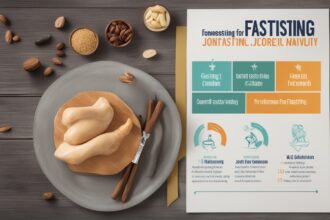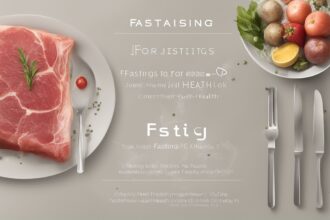Intermittent fasting has gained significant attention in recent years as a powerful tool for improving overall health, including weight management, metabolic health, and even chronic pain relief. Among its potential benefits, many individuals are exploring intermittent fasting for joint pain relief. Joint pain, often caused by inflammation, arthritis, or wear and tear, can be debilitating, and finding natural ways to alleviate it is a priority for many. In this comprehensive guide, we’ll dive into how intermittent fasting may help reduce joint pain, the science behind it, and practical tips for incorporating this eating pattern into your lifestyle.
What Is Intermittent Fasting and How Does It Work?
Intermittent fasting (IF) is an eating pattern that alternates between periods of eating and fasting. Unlike traditional diets that focus on what you eat, IF focuses on when you eat. Common methods include the 16/8 approach (fasting for 16 hours and eating during an 8-hour window) and the 5:2 method (eating normally for five days and restricting calories on two non-consecutive days). During fasting periods, the body undergoes metabolic changes, such as reduced insulin levels and increased production of ketones, which may contribute to health benefits like reduced inflammation—a key factor in joint pain.
The connection between intermittent fasting and joint pain relief lies in its potential to lower systemic inflammation. Chronic inflammation is often a root cause of joint discomfort, particularly in conditions like rheumatoid arthritis and osteoarthritis. By giving the digestive system a break, IF may help the body focus on repair and recovery processes, potentially easing joint pain over time.
The Link Between Intermittent Fasting and Joint Pain Relief
Research suggests that intermittent fasting can reduce inflammation by lowering levels of pro-inflammatory markers in the body, such as C-reactive protein (CRP) and interleukin-6 (IL-6). These markers are often elevated in individuals with joint pain conditions. Fasting also promotes autophagy, a cellular “clean-up” process where the body removes damaged cells and regenerates healthier ones. This process may help repair joint tissues and reduce pain.
Additionally, weight loss—a common result of intermittent fasting—can significantly alleviate joint pain, especially in weight-bearing joints like the knees and hips. Excess body weight puts additional stress on these joints, exacerbating pain and inflammation. By adopting intermittent fasting, individuals may experience joint pain relief as a secondary benefit of shedding extra pounds. For more insights on how weight impacts joint health, check out our post on Managing Joint Pain Through Weight Loss.
Scientific Evidence Supporting Intermittent Fasting for Joint Pain
While research on intermittent fasting specifically for joint pain relief is still emerging, several studies highlight its anti-inflammatory and pain-reducing potential. A 2019 study published in the journal Cell Metabolism found that fasting-mimicking diets reduced inflammation and improved symptoms in autoimmune conditions, which often involve joint pain. Another study in Arthritis Research & Therapy noted that caloric restriction, a component of some fasting protocols, could decrease pain and stiffness in patients with osteoarthritis.
Moreover, intermittent fasting may improve gut health by promoting a balanced microbiome, which plays a role in systemic inflammation. A healthier gut can lead to lower inflammation levels, potentially benefiting joint health. While more human studies are needed to solidify these claims, early evidence is promising for those seeking natural ways to manage joint pain. To learn more about inflammation and joint health, read our article on Natural Anti-Inflammatory Strategies for Joint Pain.
Practical Tips for Starting Intermittent Fasting for Joint Pain Relief
If you’re considering intermittent fasting for joint pain relief, it’s important to start slowly and consult with a healthcare provider, especially if you have underlying health conditions or are on medication. Here are some actionable tips to begin:
- Choose a Sustainable Method: Start with the 16/8 method, fasting overnight and eating during a midday-to-evening window. This is often easier for beginners.
- Stay Hydrated: Drink plenty of water during fasting periods to support joint lubrication and overall health.
- Focus on Nutrient-Dense Foods: During eating windows, prioritize anti-inflammatory foods like fatty fish, nuts, seeds, and leafy greens to support joint health.
- Monitor Your Body: Keep a journal to track changes in joint pain, energy levels, and overall well-being as you adapt to fasting.
- Avoid Overeating: Resist the urge to overeat during eating windows, as this can counteract the anti-inflammatory benefits of fasting.
For additional guidance on creating an anti-inflammatory diet, explore our post on Anti-Inflammatory Foods for Joint Health.
Potential Risks and Considerations
While intermittent fasting shows promise for joint pain relief, it’s not suitable for everyone. Certain individuals, such as those with diabetes, eating disorders, or pregnant women, should avoid fasting unless under medical supervision. Additionally, fasting can initially cause fatigue, irritability, or headaches, which may temporarily worsen joint pain if stress levels rise. It’s crucial to listen to your body and stop if you experience adverse effects.
Another consideration is maintaining muscle mass, as prolonged fasting without proper nutrition can lead to muscle loss, potentially weakening the support around joints. Pairing IF with light strength training and adequate protein intake can help mitigate this risk. For more on protecting joint-supporting muscles, see our guide to Strength Training for Joint Stability.
Combining Intermittent Fasting with Other Joint Health Strategies
Intermittent fasting is most effective when combined with other joint health practices. Regular low-impact exercise, such as swimming or yoga, can improve joint mobility and reduce stiffness. Additionally, supplements like omega-3 fatty acids or turmeric may enhance the anti-inflammatory effects of fasting. Stress management techniques, such as meditation, can also lower inflammation by reducing cortisol levels, further supporting joint pain relief.
Remember that intermittent fasting is not a quick fix. It works best as part of a holistic approach to health. For a broader look at complementary therapies, check out our article on Holistic Approaches to Joint Pain Management.
Disclaimer: The information provided in this article is for educational purposes only and should not be considered medical advice. Intermittent fasting may not be suitable for everyone, and its effects on joint pain can vary. Always consult with a healthcare professional or qualified medical practitioner before starting any new dietary or fasting regimen, especially if you have pre-existing health conditions or are taking medications. The authors and publishers of this content are not responsible for any adverse effects or consequences resulting from the use of the information provided.
References
- Choi, I. Y., et al. (2019). A Diet Mimicking Fasting Promotes Regeneration and Reduces Autoimmunity and Multiple Sclerosis Symptoms. Cell Metabolism.
- Messier, S. P., et al. (2017). Effects of Intensive Diet and Exercise on Knee Joint Loads, Inflammation, and Clinical Outcomes Among Overweight and Obese Adults with Knee Osteoarthritis. Arthritis Research & Therapy.
- Harvard Health Publishing. (2018). Intermittent Fasting: Surprising Update.
- Longo, V. D., & Mattson, M. P. (2019). Fasting: Molecular Mechanisms and Clinical Applications. National Library of Medicine.
- Mayo Clinic. (2020). Intermittent Fasting: What Is It, and How Does It Work?






